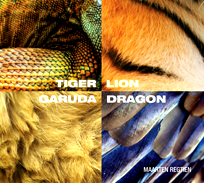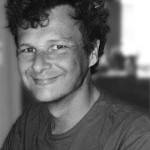Monday
Scene and HeardCarried by the Music
 Sarah Marijnissen, journalist for the the BOS (Dutch Buddhist Broadcasting Foundation), made a 30-minutes radio special about the making of the new CD, Tiger Lion Garuda Dragon, featuring four improvisations inspired by the four dignities by Dutch composer/pianist Maarten Regtien. This article is a transcription of Sarah Marijnissen’s radio special.
Sarah Marijnissen, journalist for the the BOS (Dutch Buddhist Broadcasting Foundation), made a 30-minutes radio special about the making of the new CD, Tiger Lion Garuda Dragon, featuring four improvisations inspired by the four dignities by Dutch composer/pianist Maarten Regtien. This article is a transcription of Sarah Marijnissen’s radio special.
interview by Sarah Marijnissen
edited by Ani Dawa Chotso
I called Maarten on Thursday morning. He was about to start his four-day meditation session that was to inspire him, to lead and guide him to the live recording scheduled next Monday. I asked him why he believes that musical improvisation is more than often not a spontaneous outcome of the things you would want to express.
“When improvising one seldom plays something really ‘new’. Such an experience of ‘new’ may perhaps happen once a month. At such a moment one is amazed, thinks it sounds nice or good and then automatically adds it to the known repertoire of improvisational elements. In fact one freezes the spontaneous moment into a more or less fixed musical trick. In my opinion improvisation is not naturally spontaneous or free. It is more like knitting together a whole bunch of known musical elements and a ‘good’ improvisation is an original patchwork of these known musical elements. That felt frustrating.”
So you feel a desire to break free from this habit. To break out?
“Yes. Improvisation is fun, but when I play something I truly never played before, that is great! There is an analogy with meditation. By meditation practice you try to get rid of your continuous chain of repetitive thoughts. In my case, I try to get rid of the chain of repetitive known musical elements. And by meditating in advance I’ll hopefully play ‘free’ music. And that of course is exciting, as I don’t know if that will actually happen.”
https://www.youtube.com/watch?v=CJ92fVBj87E
What do the Four Dignities mean to you?
“They’re the four concepts or symbols that can help in our meditation practice, though I am more inclined to explain them in daily-life examples. For example, if you are a carpenter and you decided to make a chair, then you just have to do so and practice a lot to build a base. That is the Tiger, the first dignity. After a few years of making furniture you’re have the confidence to make a decent chair. The second dignity is the Lion. For me that’s joy acquired through discipline. By perseverance or discipline you have become a skilled carpenter and making fine furniture offers you satisfaction and joy. All the work you’ve done starts to pay off.”
“The next dignity, the Garuda, is outrageous, for the carpenter (he or she) can make an extraordinary chair. The carpenter has a bold design idea that at first has nothing to do with the chair at all and everybody advises against it. But the carpenter has become such a craftsman that the outcome still becomes a very good product. He or she is such an expert that an experiment, an outrageous act, truly can become something worthwhile.”
And that’s what you are doing now!
“Yes, exactly. I’m doing something outrageous, but with some confidence in my ability as an improviser as I have thoroughly built up my base. If I didn’t have the confidence, the experiment most certainly would fail.”
And the fourth dignity…?
“…is the dragon, which stands for wisdom and acceptance of life as is, in all its unpredictability. And that’s tough. Anything can happen at any moment and you’re wise if you can handle any situation in a healthy manner.”
After our conversation Maarten entered four days of meditation in silence. The following Monday, I went to the Musicord Studios in Haarlem, Netherlands where the Four Dignities were about to be recorded. At 10 o’clock sharp, Maarten entered the studio, talked briefly to the recording engineer and went into the recording room. For a minute he played a few scales, tried out the keys, listened to the grand piano sound sharply and then dove into a ten minute meditation. When ready, he gave a sign to the recording engineer, and started playing Tiger: soft solemn dark bass notes. After finishing Tiger he again meditated, played Lion, meditated again and so forth. As soon as the last notes of Dragon had been played and the engineer stopped the machines, I entered the recording room and asked Maarten how he felt about the recording session.
“It was heavy, very heavy and intense. Especially the first part of Tiger. After the Tiger I meditated which I really needed to get all the tension out of my blood and clear my head for the next piece.”
What was the intensity of the Tiger?
“Building the base in the bass notes took some five or six minutes, and as I wanted to play every note with total attention the result for me became very intense. I wanted there to be repetition and variation. To enable that I had to remember what I had played and use that along the line. This process makes it intense as well.”
When playing the Lion you stopped twice.
“For the Lion my instruction was to use the piano as a drum for at least 10 minutes in a very strict rhythm, and acquire the joy from being able to do so. I was not able to play the rhythm I had in mind, which was something I had written in a classical piece five years ago. So I tried it again for a second time but that didn’t work out either. Then I decided to do something radically different. Still fast rhythms, but totally different.”
Did you experience moments when you lost yourself in your music?
“A few, yes. Those are the finest. It happened largely during the first half of the Dragon. That was in the first minutes, before I had to work towards a conclusion. It also happened somewhere in the minimal part of the Tiger. At such moments I am carried by the music, there’s no ‘me’ anymore.”
With what sort of feeling did you enter the studio this morning?
“I was a bit nervous but still felt the inner rest I had acquired through four days of sitting.”
Can you describe that inner rest?
“I think it is a kind of mental relaxation. The thoughts keep on coming but there’s no reaction upon the thoughts anymore. They are just thoughts, they lose their meaning or their importance you normally associate them with.”
Are you going to adjust the recordings before they will be burned on cd?
“That wouldn’t be fair, would it? I do feel an inclination towards it, of course, but no, I’ll leave it as is.”
~~
 If you would like to order your copy of the CD, please email Maarten Regtien at: [email protected]
If you would like to order your copy of the CD, please email Maarten Regtien at: [email protected]
Maarten Regtien started playing classical piano at the age of seven. After his musical studies Maarten began a career encompassing work as a nurse and as a piano technician at the Dutch Andriessen piano firm in Haarlem, Netherlands. He is currently working as a Microsoft software developer. Maarten also works in support of the Gesar Fund and has been the Chief Editor of the Dutch Drala Magazine.
For more information about Maarten, visit his website: www.regtien.info
















